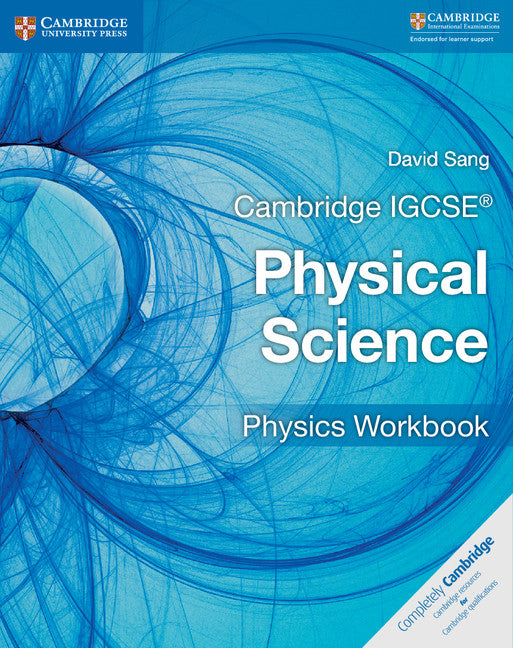Freshly Printed - allow 3 days lead
Couldn't load pickup availability
Cambridge IGCSE® Physical Science Physics Workbook
Cambridge IGCSE® Physical Science resources tailored to the 0652 syllabus for first examination in 2019, and all components of the series are endorsed by Cambridge International Examinations.
David Sang (Author)
9781316633526, Cambridge University Press
Paperback / softback, published 16 February 2017
178 pages
27.7 x 22.1 x 1 cm, 0.49 kg
Cambridge IGCSE® Physical Science resources tailored to the 0652 syllabus for first examination in 2019, and all components of the series are endorsed by Cambridge International Examinations. This Physics Workbook is tailored to the Cambridge IGCSE® Physical Science (0652) syllabus for first examination in 2019 and is endorsed for learner support by Cambridge International Examinations. The workbook covers both the Core and the Supplement material with exercises that are designed to develop students' skills in problem-solving and data handling, planning investigations and application of theory to practice. Answers are provided at the back of the book.
Introduction
How to use this book
P1. Making measurements
P1.1 The SI system of units
P1.2 Paper measurements
P1.3 Density data
P1.4 Testing your body clock
P2. Describing motion
P2.1 Measuring speed
P2.2 Speed calculations
P2.3 More speed calculations
P2.4 Distance–time graphs
P2.5 Acceleration
P2.6 Velocity–time graphs
P3. Forces and motion
P3.1 Identifying forces
P3.2 The effects of forces
P3.3 Combining forces
P3.4 Force, mass and acceleration
P3.5 Mass and weight
P3.6 Falling
P4. Turning effects of forces
P4.1 Turning effect of a force
P4.2 Calculating moments
P4.3 Stability and centre of mass
P4.4 Make a mobile
P5. Forces and matter
P5.1 Stretching a spring
P5.2 Stretching rubber
P5.3 Pressure
P6. Energy transformations and energy transfers
P6.1 Recognising forms of energy
P6.2 Energy efficiency
P6.3 Energy calculations
P7. Energy resources
P7.1 Renewables and non-renewables
P7.2 Wind energy
P7.3 Energy from the Sun
P8. Work and power
P8.1 Forces doing work, transferring energy
P8.2 Calculating work done
P8.3 Measuring work done
P8.4 Power
P9. The kinetic model of matter
P9.1 Changes of state
P9.2 The kinetic model of matter
P9.3 Understanding gases
P10. Thermal properties of matter
P10.1 Calibrating a thermometer
P10.2 Demonstrating thermal expansion
P10.3 Thermal expansion
P11. Thermal (heat) energy transfers
P11.1 Conductors of heat
P11.2 Convection currents
P11.3 Radiation
P11.4 Losing heat
P12. Sound
P12.1 Sound on the move
P12.2 Sound as a wave
P13. Light
P13.1 On reflection
P13.2 Refraction of light
P13.3 The changing speed of light
P13.4 A perfect mirror
P13.5 Image in a lens
P14. Properties of waves
P14.1 Describing waves
P14.2 The speed of waves
P14.3 Wave phenomena
P15. Spectra
P15.1 Electromagnetic waves
P15.2 Using electromagnetic radiation
P16. Magnetism
P16.1 Attraction and repulsion
P16.2 Make a magnet
P16.3 Magnetic fields
P17. Static electricity
P17.1 Attraction and repulsion
P17.2 Moving charges
P17.3 Static at home
P18. Electrical quantities
P18.1 Current in a circuit
P18.2 Current and charge
P18.3 Electrical resistance
P18.4 Electrical energy and power
P19. Electric circuits
P19.1 Circuit components and their symbols
P19.2 Resistor combinations
P19.3 More resistor combinations
P19.4 Electrical safety
P20. Electromagnetism
P20.1 Using electromagnetism
P20.2 Electricity generation
P20.3 Transformers
P21. The nuclear atom
P21.1 The structure of the atom
P21.1 Isotopes
P22. Radioactivity
P22.1 The nature of radiation
P22.2 Radioactive decay equations
P22.3 Radioactive decay
Answers.
Subject Areas: Educational: Physics [YQSP], Educational: Sciences, general science [YQS], Educational material [YQ], Teaching of a specific subject [JNU]


